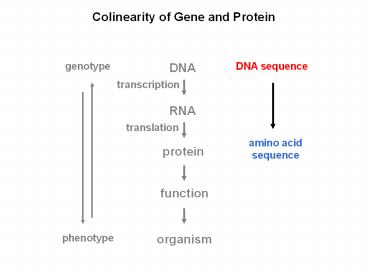Colinearity%20of%20Gene%20and%20Protein - PowerPoint PPT Presentation
Title:
Colinearity%20of%20Gene%20and%20Protein
Description:
Colinearity of Gene and Protein DNA genotype DNA sequence transcription RNA translation amino acid sequence protein function organism phenotype Molecular Basis for ... – PowerPoint PPT presentation
Number of Views:366
Avg rating:3.0/5.0
Title: Colinearity%20of%20Gene%20and%20Protein
1
Colinearity of Gene and Protein
DNA
genotype
DNA sequence
transcription
RNA
translation
amino acid sequence
protein
function
organism
phenotype
2
Molecular Basis for Relationship between Genotype
and Phenotype
DNA
genotype
DNA sequence
transcription
RNA
translation
amino acid sequence
protein
function
organism
phenotype
3
Protein Synthesis Initiation in Prokaryotes
Shine-Dalgarno sequence pairs with 16S rRNA of
30S subunit. IF3 keeps 30S subunit dissociated
from 50S subunit. Formyl group is added to
methionine when associated with the initiator
tRNA. IF1 and IF2 allows only initiator tRNA to
enter P site. Initiation factors are released
when two ribosomal subunits associate.
4
Protein Synthesis Initiation in
Eukaryotes eIF4A, eIF4B, and eIF4G associates
with 5 end, then with 40S subunit and initiator
tRNA. mRNA is unwound by movement of this
complex in 5 -gt 3 direction. 60S subunit
associates with initiation complex when start
codon is recognized. Initiation factors are
released when the two ribosomal subunits
associate.
5
Proteins and RNA Molecules Compose the Two
Subunits of a Ribosome
6
Important Features of Ribosome
A - aminoacyl site P - peptidyl site E -
exit site
7
Protein Synthesis Elongation
EF-Tu associates with aminoacyl-tRNA to form a
ternary complex.
Correct match of ternary complex with codon in A
site (decoding center) changes conformation of
ribosome. EF-Tu leaves ternary complex, and
peptide bond is formed between amino acids as
amino acids are positioned together in
peptidyltransferase center.
Amino acid in P site is transferred to amino acid
in A site. Translocation requires GTP and EF-G.
EF-G enters A site, shifting tRNAs. When EF-G
leaves, A site is open for a new ternary complex.
A new ternary complex associates with A site,
and deacylated tRNA leaves from E site.
8
Protein Synthesis Termination tRNA molecules do
not recognize stop codons. Termination codons
are recognized by release factors. (RF1, RF2, RF3
in bacteria) UAA and UAG are recognized by
RF1. UAA and UGA are recognized by RF2. RF3
assists in release activity. Release factors
bind to a stop codon in the A site by association
between codon and tripeptide of RF. Polypeptide
is released from P site when RF fits into A
site. Release of polypeptide is followed by
dissociation of ribosomal subunits.
9
Molecular Basis for Relationship between Genotype
and Phenotype
DNA
genotype
DNA sequence
transcription
RNA
translation
amino acid sequence
protein
function
organism
phenotype
10
Molecular Basis for Relationship between Genotype
and Phenotype
DNA
genotype
DNA sequence
transcription
RNA
translation
amino acid sequence
protein
function
organism
phenotype
11
Universality of Genetic Information
Transfer Genetic code is essentially identical
for all organisms. There are exceptions. System
AUA
UGA universal isoleucine
termination mammalian mitochondria
methionine tryptophan yeast
mitochondria isoleucine
tryptophan
12
Comparison of Gene Expression
Prokaryotes One type of RNA polymerase
synthesizes all RNA molecules. mRNA is
translated during transcription. Genes are not
split. They are continguous segments of
DNA. mRNAs are often polycistronic.
Eukaryotes Three different types of RNA
polymerases synthesize different classes of
RNA. mRNA is processed before translation. Genes
are often split. They are not continguous
segments of coding sequences. mRNAs are mostly
monocistronic.
13
All Protein Interactions in an Organism Compose
the Interactome
Proteome Complete set of proteins produced by
genetic material of an organism. Interactom
e Complete set of protein interactions in an
organism.































